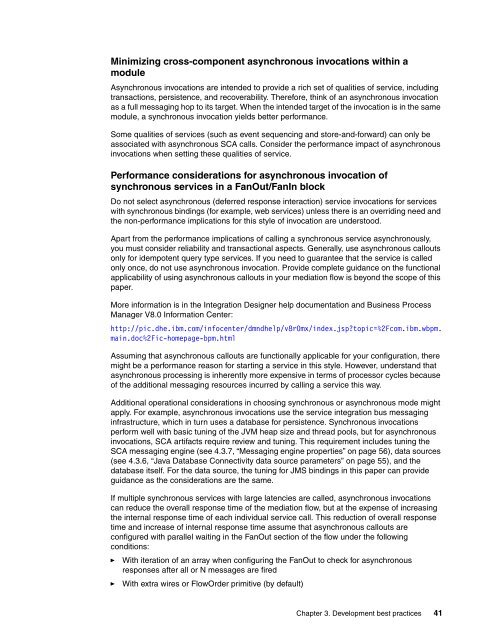Download PDF (1.3 MB) - IBM Redbooks
Download PDF (1.3 MB) - IBM Redbooks
Download PDF (1.3 MB) - IBM Redbooks
Create successful ePaper yourself
Turn your PDF publications into a flip-book with our unique Google optimized e-Paper software.
Minimizing cross-component asynchronous invocations within a<br />
module<br />
Asynchronous invocations are intended to provide a rich set of qualities of service, including<br />
transactions, persistence, and recoverability. Therefore, think of an asynchronous invocation<br />
as a full messaging hop to its target. When the intended target of the invocation is in the same<br />
module, a synchronous invocation yields better performance.<br />
Some qualities of services (such as event sequencing and store-and-forward) can only be<br />
associated with asynchronous SCA calls. Consider the performance impact of asynchronous<br />
invocations when setting these qualities of service.<br />
Performance considerations for asynchronous invocation of<br />
synchronous services in a FanOut/FanIn block<br />
Do not select asynchronous (deferred response interaction) service invocations for services<br />
with synchronous bindings (for example, web services) unless there is an overriding need and<br />
the non-performance implications for this style of invocation are understood.<br />
Apart from the performance implications of calling a synchronous service asynchronously,<br />
you must consider reliability and transactional aspects. Generally, use asynchronous callouts<br />
only for idempotent query type services. If you need to guarantee that the service is called<br />
only once, do not use asynchronous invocation. Provide complete guidance on the functional<br />
applicability of using asynchronous callouts in your mediation flow is beyond the scope of this<br />
paper.<br />
More information is in the Integration Designer help documentation and Business Process<br />
Manager V8.0 Information Center:<br />
http://pic.dhe.ibm.com/infocenter/dmndhelp/v8r0mx/index.jsp?topic=%2Fcom.ibm.wbpm.<br />
main.doc%2Fic-homepage-bpm.html<br />
Assuming that asynchronous callouts are functionally applicable for your configuration, there<br />
might be a performance reason for starting a service in this style. However, understand that<br />
asynchronous processing is inherently more expensive in terms of processor cycles because<br />
of the additional messaging resources incurred by calling a service this way.<br />
Additional operational considerations in choosing synchronous or asynchronous mode might<br />
apply. For example, asynchronous invocations use the service integration bus messaging<br />
infrastructure, which in turn uses a database for persistence. Synchronous invocations<br />
perform well with basic tuning of the JVM heap size and thread pools, but for asynchronous<br />
invocations, SCA artifacts require review and tuning. This requirement includes tuning the<br />
SCA messaging engine (see 4.3.7, “Messaging engine properties” on page 56), data sources<br />
(see 4.3.6, “Java Database Connectivity data source parameters” on page 55), and the<br />
database itself. For the data source, the tuning for JMS bindings in this paper can provide<br />
guidance as the considerations are the same.<br />
If multiple synchronous services with large latencies are called, asynchronous invocations<br />
can reduce the overall response time of the mediation flow, but at the expense of increasing<br />
the internal response time of each individual service call. This reduction of overall response<br />
time and increase of internal response time assume that asynchronous callouts are<br />
configured with parallel waiting in the FanOut section of the flow under the following<br />
conditions:<br />
►<br />
►<br />
With iteration of an array when configuring the FanOut to check for asynchronous<br />
responses after all or N messages are fired<br />
With extra wires or FlowOrder primitive (by default)<br />
Chapter 3. Development best practices 41
















